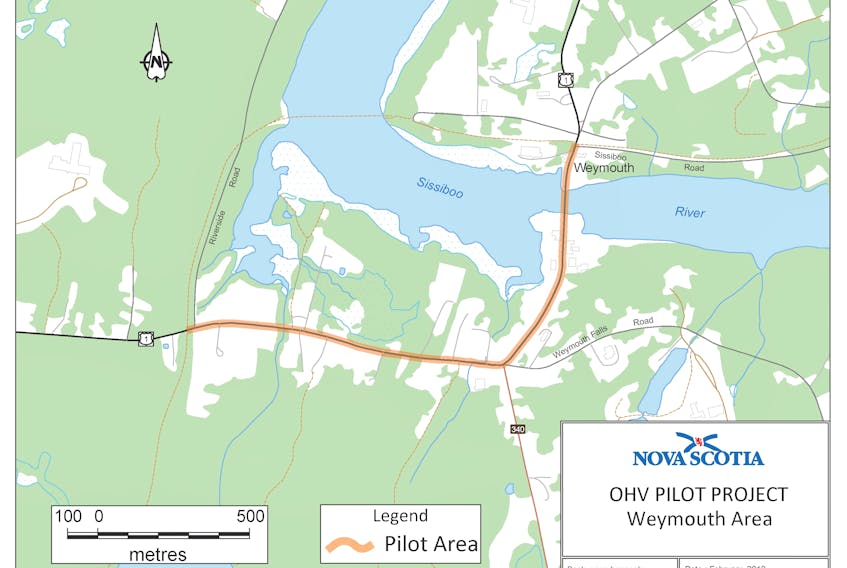WEYMOUTH, N.S. — BY ANITA FLOWERS
New signage has helped riders on the Weymouth OHV (Off-Highway Vehicle) Share the Road pilot project more easily find their way to connecting trails.
The Share the Road project officially opened a year ago, in October 2018. The pilot project allows ATV riders to legally ride on limited portions of provincial roads, which connect off-road trails, or to access facilities in selected pilot areas.
Previously, ATV riders were forced to drive illegally on the highway to reach areas of the trails that are not connected.
The first year of the project has been a success, according to Barry Barnet, executive director of the ATV Association of Nova Scotia (ATVANS).
“The Share the Road program has been excellent. We’ve had zero complaints about the actual project in Weymouth and in six other sites around the province,” he says. “The only complaints have been from ATV riders in other locations where there isn’t a pilot project who would like to have more access to trails in their area.”
Seven communities in Nova Scotia are part of the pilot project: Weymouth, Ship Harbour, Porters Lake, New Germany, Walton, Sherbrooke and Gabarus. The pilot project will give the Department of Transportation and Infrastructure Renewal an opportunity to evaluate the integration of OHVs onto roadways and to help determine whether a permanent solution is viable.
POSITIVE ECONOMIC IMPACT
The project has also been a boon for the local economy, says Barnet.

“It’s had a significant impact on businesses. ATVs can now travel to pick up fuel, to stop at restaurants and shops and even use overnight accommodations in the area,” he says. “We’re hearing positive stories from local businesses. They are able to open longer hours and extend their seasons.”
Keith Comeau, president of the Digby County ATV club, echoed these positive sentiments.
“It’s been a boost for business in Weymouth, from the gas station to the pizza shop. Riders now have access to amenities legally,” he says.
“In June this year, we had 80 to 90 ATVs at ATV Appreciation Days.”
According to Comeau, the Digby ATV Club has about 80 to 90 members and the Sou’west Nova ATV association in Yarmouth has about 200.
“But there are many more ATV riders who aren’t part of our associations,” Comeau says.
The expanded access to trails brings riders from other parts of the province.
“We can legally ride from downtown Digby to the old train station at downtown Yarmouth,” he says. “The only road we can go any length on is in Weymouth, from track to track.”
Riders are allowed on the highway for only 1.8 kilometres.
“It’s a nice pastime and you get to see a lot of nice country – things you wouldn’t see just from the highway,” says Comeau.
DIRECTION ASSISTANCE
Comeau assisted ATVANS trails coordinator, Corey Robar, in placing new signage on the trails in August of this year. According to Barnet, new signs have helped riders find their way on the trails.
“Riders would come out to the end of the trail, but they wouldn’t know which way to turn. It redirects them in the right way,” says Barnet.
The new signage also calls out the important rules for riding on the highway.
Off-highway vehicles are to travel on the shoulder of the highway in the direction of traffic. The speed limit is posted at 25 kilometres per hour and travel is only permitted during daylight hours.
The pilot project was given three years as a trial by the provincial government.
“There shouldn’t be any issue making it permanent. We have also approached the government about adding some additional priority sites that would expand the program,” Barnet says.
OHV WEYMOUTH PILOT PROJECT RULES
• Max speed 25km/h
• Travel only permitted between one half hour before sunrise and one half hour after sunset.
• OHVs (off highway vehicles) to be driven on the shoulder of the designated highway only, in the same direction as traffic using the same side of the highway.
• OHVs permitted to be driven on the roadways in the same direction as traffic using the same side of the highway if…
- There is no shoulder
- The shoulder is obstructed
- When preparing to make a left turn across the road
- If shoulder is not wide enough to be driven with all tires completely off the roadway
• OHV must be registered and insured as per the OHV Act
• Driver must have a valid drivers licence
• No passenger on an OHV in a pilot area can be younger than 9 years old.









